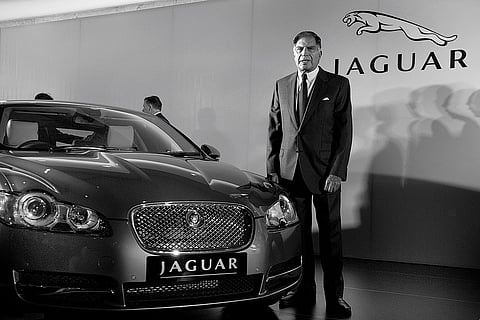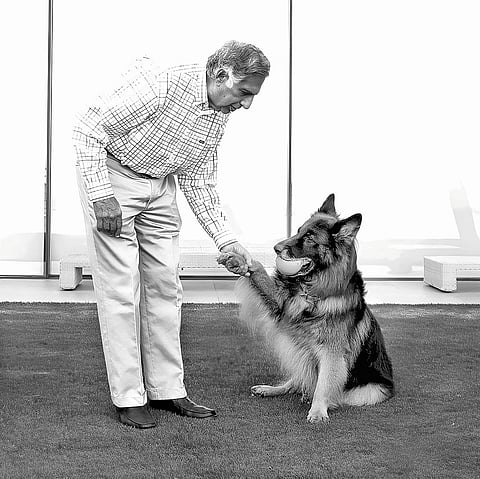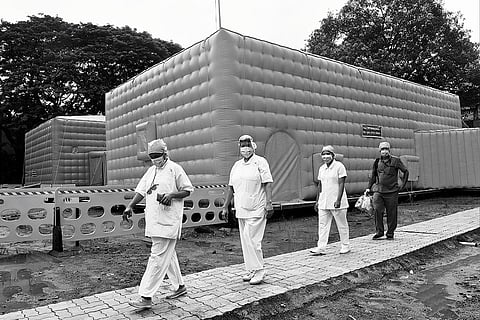This story was published as part of Outlook's 1 November, 2024 magazine issue titled 'Bittersweet Symphony'. To read more stories from the issue, click here
Of Cars, Kings And Dogs: A Ratan Tata Snapshot
Ratan Tata joined the Tata Group in 1962 and held various positions across companies before stepping down as the chairperson in 2012
Ratan Tata, who took the homegrown Tata Group to global heights, passed away on October 9, 2024, in Mumbai. He was 86. Having led the conglomerate, whose business interests range from steel, automobiles and consumer products to software and financial services, for more than two decades, Ratan Tata was widely respected for his professional acumen as well as his personal ethics and philanthropic activities.
During his career spanning five decades, Ratan Tata faced many challenges, which he handled with equanimity. His charitable contributions to healthcare, education and rural development leave behind a lasting legacy.

Journey at Tata Group Begins
Ratan Tata returned to India in 1962 after studying architecture and structural engineering at Cornell University in the United States. He had secured a job at IBM, but his uncle J.R.D. Tata wanted him to work for the Tata Group and he was offered a job at Tata Industries. “We were close and we were not,” Tata wrote in a special publication celebrating the lives of Jamsetji Tata, J.R.D. Tata, and Naval Tata. “I left India when I was 15 for a decade. I would have to say that, as often happens between a father and a son, there was, perhaps, a divergence of views.”
Tata joined the group and later in his stint, he spent six months training at the Jamshedpur plant of Tata Engineering and Locomotive Company (now Tata Motors) before joining Tata Iron and Steel Company or TISCO, (now Tata Steel). After spending years across companies in the group, Ratan Tata joined the board of Tata Sons as a director in 1974.

The Ford-Tata Story
In 1998, when Ratan Tata’s dream project and India’s first hatchback, the Tata Indica, faced failure in the market, Tata decided to sell the motor business. Ratan Tata and representatives of American motor giant Ford met at Bombay House for talks in 1999, after which Ratan Tata and his team flew to Detroit to meet Bill Ford, the then chairperson of Ford. The three-hour-long meeting did not go well for Ratan Tata and Ford told him they would be doing the Tata Group a favour by buying the car business. Understandably, this didn’t go down well with Ratan Tata and he called off the sale.
After a few years, things took a turn. Ford began to incur losses in its business with Jaguar Land Rover. Some estimates showed that Ford had spent $2.5 billion for Jaguar in 1989 and $2.7 billion for Land Rover in 2000, but managed to earn just $1.7 billion from the sales of the two brands. This was further fuelled by the global financial crisis in 2008, when Ford faced severe financial woes, pushing it to the brink of bankruptcy. During this time, Tata Motors grew into a significant player in the automotive industry in India. Ratan Tata decided to acquire Jaguar Land Rover from Ford. The total deal was executed for a mere $2.3 billion. Pravin Kadle, who was one of the members of the team that travelled with Ratan Tata to the US in 1999, said at a public event in 2015 that Bill Ford had thanked Tata, saying, “You are doing us a big favour by buying JLR.”

The Nano-Singur Debacle
In 2006, at his first press conference after the Communist Party of India (Marxist)-led Left Front was re-elected to power in West Bengal, Chief Minister Buddhadeb Bhattacharjee announced the setting up of a Tata Motors car factory at Singur in Hooghly district. The factory would be used for manufacturing Tata Nano, one of the budget-friendly cars in India at that time. Following the announcement, there was a widespread perception that the Communist government in the state was forcibly acquiring agricultural land for industrial use.
Massive protests broke out in the state, and on October 3, 2008, Tata Motors announced its decision to pull the production of the Nano from Singur and shift it to Sanand in Gujarat. However, at an annual general meeting of Tata Global Beverages Limited in 2012, Ratan Tata indicated that he had not given up on West Bengal. “There could be a Tata Motors factory in West Bengal in the future. Who knows?” he said.

Love for Animals
In 2018, Ratan Tata was to be awarded the Lifetime Achievement Award for philanthropy at Buckingham Palace at an event organised by King Charles (then-Prince). According to reports, Ratan Tata did not visit Buckingham Palace to receive the award because his dogs Tito and Tango had fallen ill. Later, when informed about the situation, King Charles (then-Prince) empathised with Tata’s decision and said: “That’s a man. That’s the man Ratan is.”
Ratan Tata’s love for dogs is on display at Bombay House, the headquarters of the Tata Group in Mumbai. The building was renovated in 2018 to ensure that dogs have a space of their own, with a controlled climate, comfortable cushions and an access door so that they can walk in and out freely. The building is home to nine dogs, including Goa, Ratan Tata’s pet, who was present when his master’s last rites were performed.

Ratan Tata’s last project was also dedicated to animals. He established the Rs 165-crore Small Animal Hospital, Mumbai (SAHM) in Mahalaxmi, Mumbai. The specialty pet hospital began operations on July 1, 2024. It has 24x7 emergency care, ICUs, and HDUs with life support for critically ill and injured animals and advanced diagnostic imaging services.
Ratan Tata’s unexpected friendship with Shantanu Naidu, a 31-year-old Tata Group employee, sprang from their shared love for dogs. Naidu had set out to design glow-in-the-dark collars for stray dogs to make it easier for drivers to spot them on the streets. In need of funding to grow his company, Naidu wrote a letter to Ratan Tata. Tata wrote back within two months, inviting Naidu to come to Mumbai and work with him. Their friendship grew and Naidu went on to call Ratan Tata his “lighthouse”.

Philanthropy
Tata led his philanthropic activities through the Tata Trusts, one among India’s oldest charitable institutions in India, which evolved under his leadership to focus on various social issues. The Trusts have contributed to healthcare, education, rural development, water, sanitation, hygiene and skill development.
In the healthcare segment, Tata’s efforts have been groundbreaking. In 2010, the Tata Trusts donated Rs 220 crore to the Tata Medical Centre in Kolkata, a state-of-the-art cancer treatment and research facility. In 2020, Tata Sons and the Tata Trusts pledged Rs 1,500 crore to support India’s fight against Covid-19. According to the annual report of the Tata Trusts for the financial year 2023, total disbursals given out by the Trusts were Rs 456.42 crore, out of which Rs 397.36 crore were made on programme grants, Rs 2.24 crore on small grants and Rs 56.82 crore on individual grants.
One of the most notable donations was given by Ratan Tata in 2008 to his alma mater, Cornell University. He donated $50 million, which was aimed at supporting higher education, particularly benefitting Indian students enrolled at the university.
(This appeared in the print as 'Of Cars, Kings And Dogs')